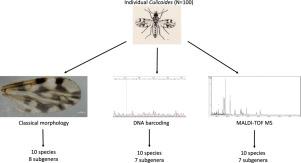Acta Tropica ( IF 2.1 ) Pub Date : 2020-07-10 , DOI: 10.1016/j.actatropica.2020.105628 Asael Rot 1 , Rudy Meiswinkel 2 , Marcelo Fleker 3 , Shlomo Eduardo Blum 3 , Adi Behar 1

|
Culicoides biting midges (Diptera: Ceratopogonidae) are a highly successful group of small (1–3 mm) hematophagous flies, infamous for the role they play as biological vectors for numerous pathogens of veterinary significance. The principal aim of the national animal disease surveillance program of Israel is to be able to rapidly sort and identify live field-captured insects including Culicoides for arbovirus screening. In this exploratory study, three identification methods—classical morphology, DNA barcoding, and MALDI-TOF MS—were applied simultaneously to individuals of 10 Culicoides species that commonly attack livestock in Israel. The strengths and limitations of the three methods are compared and evaluated. In essence, the CO1 barcoding and MALDI-TOF MS results closely matched those of classical morphology. Furthermore, at a higher level and in strong accordance with recognized subgenera, the 10 species, in the reconstructed phylogenies, coalesced into multiple deeper-branched monophyletic clades. However, some discrepancies between the molecular and protein profiling results did occur and proved difficult to assess in terms of taxonomic significance. This difficulty underscores how tricky it is to establish clear species limits when methods involving borderline cutoff values and similarity indices are used as a taxonomic aid. An added shortcoming of the pluralistic triple-method approach is that a significant percentage of the species-level depositions in the GenBank and BOLD databases are misidentified, hindering structured comparison and interpretation of the morphological and molecular results obtained. Aspects of the unresolved taxonomy of various biting midge assemblages within the Mediterranean basin, including minor changes to the Israeli Culicoides checklist, are discussed in light of the methods applied. It is observed that the direct access that classical morphology provides to the external environment (or species niche) is indispensable to the full and correct interpretation (and application) of concomitant molecular and protein profiling results. The Culicoides taxonomy of the future ought to be fully integrative, during which the assimilation of modern methodological advances should strengthen—rather than undermine—the morphological foundations laid down during the 260-year Linnaean epoch.
中文翻译:

要使用经典形态学,mtDNA条形码和MALDI-TOF MS蛋白谱分析来实现地中海地中海分类学的现代化。
库蚊咬mid(Diptera:Ceratopogonidae)是一种非常成功的小型(1-3 mm)食血性蝇类,以它们作为具有多种重要兽医学病原体的生物载体的作用而臭名昭著。以色列国家动物疾病监测计划的主要目标是能够快速分类和识别现场捕获的活虫,包括用于虫媒病毒筛选的库里科尼德虫。在这项探索性研究中,将三种鉴定方法(经典形态,DNA条形码和MALDI-TOF MS)同时应用于10种通常在以色列袭击牲畜的库里科物种的个体。比较和评估了这三种方法的优势和局限性。本质上,CO1条码和MALDI-TOF MS结果与经典形态学非常接近。此外,在更高的水平上,并与公认的亚属高度一致,在重建的系统发育中,这10个物种合并成多个更深的分支单系进化枝。但是,确实发生了分子和蛋白质谱分析结果之间的某些差异,并证明很难根据分类学意义进行评估。这一困难凸显了当使用涉及临界值和相似性指数的方法作为生物分类学援助时,建立明确的物种限制是多么棘手。多元三元方法的另一个缺点是,GenBank和BOLD数据库中很大一部分物种级沉积物被错误识别,妨碍结构比较和解释所获得的形态和分子结果。地中海盆地内各种尖锐的ge类生物尚未解决的分类学问题,包括对以色列的微小改动根据所用方法讨论了库里科德清单。据观察,经典形态学提供给外部环境(或物种生态位)的直接访问对于伴随的分子和蛋白质谱分析结果的完整和正确的解释(和应用)是必不可少的。未来的库里科德分类法应该是完全整合的,在此期间,对现代方法学进步的吸收应加强而不是破坏260年林奈时代所奠定的形态基础。











































 京公网安备 11010802027423号
京公网安备 11010802027423号